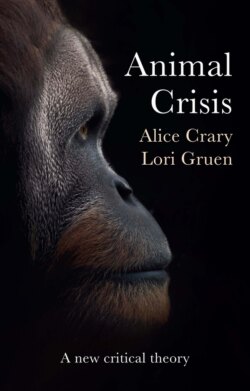Читать книгу Animal Crisis - Alice Crary - Страница 10
The Rapidly Expanding Problem
ОглавлениеThe environmental destruction that is harming the island inhabitants, human and nonhuman, on Borneo and Sumatra represents just a fraction of the unfolding catastrophe around the globe. Human activities are polluting and destroying animal habitats on land and sea at such an astonishing rate that we are confronting a “sixth mass extinction” (Kolbert 2014). Pollution is heating the seas and leaving them strewn with plastic detritus that degrades – as of this writing – nearly 90 percent of the ecosystems of the world’s oceans (Jones et al. 2018), while the size and number of fertilizer-laden, run-off-triggered, hypoxic aquatic “dead zones” continue to grow.
The destruction of land-based ecosystems has reached a similar scale and is intensifying. Just as on Borneo and Sumatra, so too the rate of animal-killing forest clearing for agriculture and other human purposes continues to increase in many parts of the world. And animals are being killed at ever higher rates by cataclysms brought on by anthropogenic climate change. It is estimated, for instance, that a billion animals were killed by the fires that scorched Australian landscapes during the first few weeks of the hot season 2019–20 (Rueb and Zaveri 2020). And the fires and unusually high temperatures in the US during the summer of 2021 killed many humans and animals, too, including more than a billion sea creatures (Cecco 2021).
Pollution and human-generated cataclysms haven’t spared animals who frequent the skies. Billions of birds have vanished in nearly all areas of North America since the 1970s – a 30 percent loss in overall numbers (Axelson 2019). This silencing of birdsong effectively augurs the “strange stillness” that Rachel Carson ominously and presciently foretold (1962: 110).
The upshot of these interrelated forms of natural devastation is the progressive destruction of life on earth, or ecocide. As environmental reporter Brooke Jarvis (2018) observes:
What we’re losing is not just the diversity part of biodiversity, but the bio part: life in sheer quantity … the world’s largest king penguin colony shrank by 88 percent in 35 years, more than 97 percent of the bluefin tuna that once lived in the ocean are gone. The number of Sophie the Giraffe toys sold in France in a single year is nine times the number of all the giraffes that still live in Africa.
Anthropogenic animal destruction also includes the deliberate creation, exploitation, and killing of animals in laboratories, hunting grounds on land and in the oceans, aqua-farms, and land-based industrial farms. Land-based factory farming alone, increasingly global in its reach, accounts for the slaughter, worldwide, of more than 200 million animals daily (Zamba 2020). The industrialized harvesting of the oceans, taken to encompass industrial fishing and the farming of fish, in turn accounts for the extermination of nearly three trillion creatures annually (Rowland 2017). These technologies of the intentional use and butchering of animals are themselves one of the biggest contributors to the decimation of animal habitats. Worldwide, animal agriculture is a significant contributor to greenhouse gas emissions. The demand for grazing terrain for farmed animals is a major factor in what scientists estimate is the loss of 12.5 million square acres of forests annually (Pearce 2018), which in turn is responsible for nearly 20 percent of the world’s greenhouse gas emissions, widespread soil erosion, and related polluting run-off into rivers, lakes, and oceans (Derouin 2019).
The reach of human activity into animal lives and environments is so extensive that it would be difficult to find any unaffected individual animal or animal population. The horrors that human beings visit on animals – incidentally as well as deliberately – are so great and of such massive proportions that, once we begin to bring them into view, we can easily feel disoriented and unable even to properly grasp them. If humans killed each other at the same rate we kill animals, the Humane League has calculated, we’d be extinct in 17 days (@HumaneLeague, July 15, 2018).
These horrors demand an urgent response. Notable political and intellectual pro-animal movements are responding. Their ongoing political interventions are multifarious, including – to give a sense of the range – rescuing animals and human beings from adverse weather events; attempting to slow the devastation of forests and oceans, for instance, by means of Indigenous land defenses and youth climate strikes; agitating for systematic political changes that would shift how humans interact with animals and the environment; helping farmers to transition to plant-based food production; bringing plant-based foods to communities without access to them; and exposing the cruel and callous treatment of animals in concentrated animal feeding operations (CAFOs) and industrial slaughterhouses.
Alongside these and other political interventions are a range of pro-animal intellectual initiatives aimed at establishing the value of animal lives in ways that would account for the felt need for urgent political responses. These intellectual projects are increasingly recognized within the academy. One sign of this is the emerging acceptance of animal ethics within the discipline of philosophy; only 20 years ago it was still a fringe subject represented at best sporadically in Western universities. In addition to becoming a recognized area of study in philosophy departments, animal ethics is taught in other departments in the humanities and the social sciences, in law schools, and in increasingly common animal studies courses and programs. The upsurge of interest in animal ethics as a field is undeniably driven in large part by the recognition that human–animal relations have reached a desperate point. At the same time, embedding the field in the institutional structures of universities risks detaching it from the kind of responsiveness to worldly events that is its original raison d’être. To counteract the scholarly tendency to disconnect from practical matters, here we interrogate received frameworks for doing animal ethics to determine whether their grounding assumptions are genuinely suited for exposing actual harms to animals and the anthropocentric institutions and systems that authorize such harm.
